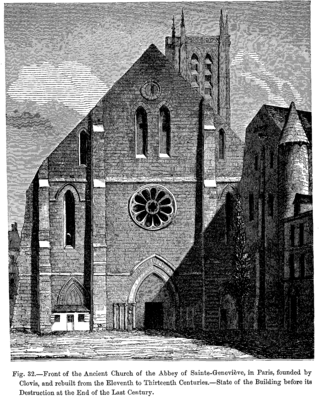
The Abbey of Saint-Pierre-le-Vif (French : Abbaye de Saint-Pierre-le-Vif) was a Benedictine monastery just outside the walls of Sens, France, in the Archdiocese of Sens.

The Abbey of Saint-Pierre-le-Vif (French : Abbaye de Saint-Pierre-le-Vif) was a Benedictine monastery just outside the walls of Sens, France, in the Archdiocese of Sens.
The first abbot of Saint-Pierre-le-Vif, Saint Ebbo, was bishop of Sens before 711. In 731 he led the people of Sens to compel the Saracens to lift their siege of the city.
Before the 9th century there was in the cemetery near the monastery a group of tombs, among which are those of the founders of the diocese and the first bishops, Savinian and Potentian. In 847, the transfer of their remains to the church of Saint-Pierre-le-Vif inspired popular devotion towards the two saints. In the middle of the 10th century their relics were hidden in a subterranean vault of the abbey to escape the pillage of the Hungarians, but in 1031 they were placed in a reliquary established by the writer Odorannus, a monk of the abbey. [1] Odorannus attributed the founding of the monastery to a Merovingian princess named Theodechild. Later historians came to identify her as a daughter of Theuderic I. [2]
The Chronicle of Saint-Pierre-le-Vif of Sens is a Latin chronicle written at the Abbey between about 1100 and 1125 with continuations added into the 13th century. The Chronicle is mainly a history of the abbey and of the city of Sens. [3]
In 1238, Baldwin II, Latin Emperor of Constantinople, sold the Crown of thorns to Louis IX of France. The following year, during the royal progress of the relic to the Sainte-Chapelle in Paris, the court stopped at Sens. the king allowed the relic to repose overnight in the abbey. [4]
During the Revolution, Étienne Charles de Loménie de Brienne, who had signed the Civil Constitution of the Clergy, bought the former abbey and had the majestic church, burial place of his predecessors as Archbishop of Sens, demolished, installing himself in the abbot's house with members of his family. [5]

Étienne Charles de Loménie de Brienne was a French clergyman, bishop, cardinal, politician and finance minister of King Louis XVI.

Saint Lupus of Sens was the nineteenth bishop of Sens.

Fontenelle Abbey or the Abbey of St. Wandrille is a Benedictine monastery in the commune of Rives-en-Seine. It was founded in 649 near Caudebec-en-Caux in Seine-Maritime, Normandy, France.
Louis of Lower Lorraine, Frankish royalty and a member of the Carolingian dynasty, was a younger son of Charles, Duke of Lower Lorraine, through his second wife, Adelaide.

Fleury Abbey (Floriacum) in Saint-Benoît-sur-Loire, Loiret, France, founded in about 640, is one of the most celebrated Benedictine monasteries of Western Europe, and possesses the relics of St. Benedict of Nursia. Its site on the banks of the Loire has always made it easily accessible from Orléans, a center of culture unbroken since Roman times. In 2010, the abbey had over forty monks led by the abbot Etienne Ricaud.

The Diocese of Troyes is a Latin Church ecclesiastical territory or diocese of the Catholic Church in Troyes, France. The diocese now comprises the département of Aube. Erected in the 4th century, the diocese is currently a suffragan diocese in the ecclesiastical province of the metropolitan Archdiocese of Reims. It was re-established in 1802 as a suffragan of the Archbishopric of Paris, when it comprised the départements of Aube and Yonne and its bishop had the titles of Troyes, Auxerre, and Châlons-sur-Marne. In 1822, the See of Châlons was created and the Bishop of Troyes lost that title. When Sens was made an archdiocese, the episcopal title of Auxerre went to it and Troyes lost also the département of Yonne, which became the Archdiocese of Sens. The Diocese of Troyes covers, besides the ancient diocesan limits, 116 parishes of the ancient Diocese of Langres and 20 belonging to the ancient diocese of Sens. On 8 December 2002, the Diocese of Troyes was returned to its ancient metropolitan, the Archbishop of Reims. As of 2022, there was one priest for every 4,320 Catholics.

The Diocese of Séez is a Latin Church diocese of the Catholic Church in France. Originally established in the 3rd century, the diocese encompasses the department of Orne in the region of Normandy. The episcopal see is the cathedral in Sées, and the diocese is a suffragan of the Archdiocese of Rouen.

The Diocese of Orléans is a Latin Church diocese of the Catholic Church in France. The diocese currently corresponds to the Départment of Loiret. The current bishop is Jacques André Blaquart, who was appointed in 2010.

Solesmes Abbey or St. Peter's Abbey, Solesmes is a Benedictine monastery in Solesmes, Sarthe, France, and the source of the restoration of Benedictine monastic life in the country under Dom Prosper Guéranger after the French Revolution. The current abbot is the Right Reverend Dom Abbot Geoffrey Kemlin, O.S.B., elected in 2022.

The Archdiocese of Sens and Auxerre is a Latin archdiocese of the Catholic Church in France. The archdiocese comprises the department of Yonne, which is in the region of Burgundy. Traditionally established in sub-apostolic times, the diocese as metropolis of Quarta Lugdunensis subsequently achieved metropolitical status. For a time, the archbishop of Sens held the title "primate of the Gauls and Germania". Until 1622, the metropolitan archdiocese numbered seven suffragan (subordinate) dioceses: the dioceses of Chartres, Auxerre, Meaux, Paris, Orléans, Nevers and Troyes, which inspired the acronym CAMPONT. The Diocese of Bethléem at Clamecy was also dependent on the metropolitan see of Sens. On December 8, 2002, as part of a general reorganization of the dioceses of France undertaken, at least in part, to respond to demographic changes, the Archdiocese of Sens-Auxerre ceased to have metropolitan rank and became a suffragan of the Archdiocese of Dijon, which became the centre of a new ecclesiastical province for the Burgundy administrative region.

The Diocese of Soissons, Laon, and Saint-Quentin is a Latin Church diocese of the Catholic Church in France. The diocese is suffragan to the Archdiocese of Reims and corresponds, with the exception of two hamlets, to the entire Department of Aisne. The current bishop is Renauld Marie François Dupont de Dinechin, appointed on 30 October 2015. In 2022, in the Diocese of Soissons there is one priest for every 5,594 Catholics.

The Abbey of Saint-Germain d'Auxerre is a former Benedictine monastery in central France, dedicated to its founder Saint Germain of Auxerre, the bishop of Auxerre, who died in 448. It was founded on the site of an oratory built by Germanus in honor of Saint Maurice.

The Diocese of Le Mans is a Latin Church diocese of the Catholic Church in France. The diocese is now a suffragan of the Archdiocese of Rennes, Dol, and Saint-Malo, but had previously been suffragan to Bourges, Paris, Sens, and Tours.

Vaux-de-Cernay Abbey is a former Cistercian monastery in northern France (Île-de-France), situated in Cernay-la-Ville, in the Diocese of Versailles, Yvelines. The abbey was abandoned during the French Revolution and fell into partial ruin. Most of the buildings, except for the church, were restored in the late 19th century by Charlotte de Rothschild, and the property is now a hotel.

Senones Abbey was a Benedictine abbey located in the valley of the Rabodeau, in the present village of Senones in Grand Est, France.

The Abbey of Saint Genevieve was a monastery in Paris. Reportedly built by Clovis, King of the Franks in 502, it became a centre of religious scholarship in the Middle Ages. It was suppressed at the time of the French Revolution.
Odorannus of Sens was a Benedictine monk at the abbey of Saint-Pierre-le-Vif in Sens, France. He was, in varying capacities, an artist, architect, goldsmith, musical theorist, biographer, exegete and chronicler.

Moissac Abbey was a Benedictine and Cluniac monastery in Moissac, Tarn-et-Garonne in south-western France. A number of its medieval buildings survive, including the abbey church, which has a famous and important Romanesque sculpture around the entrance.

Lagny Abbey was a monastery situated in the present-day commune of Lagny-sur-Marne in the department of Seine-et-Marne in France, in the eastern suburbs of Paris. It was founded in 644, refounded about 990 and after well over a millennium of existence was seized by the state at the French Revolution.
The Chronicle of Saint-Pierre-le-Vif of Sens is an anonymous Latin chronicle written at the Abbey of Saint-Pierre-le-Vif in Sens between about 1100 and 1125 with continuations added into the 13th century. The original work was attributed to a monk named Clarius by Dom Victor Cottron in 1650, but this is not now accepted. It is, however, sometimes still labeled the Chronique dite de Clarius. The Chronicle is mainly a history of the abbey and of the city of Sens.
48°11′52″N3°17′46″E / 48.19778°N 3.29611°E